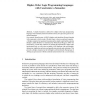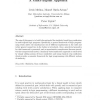104 search results - page 10 / 21 » Computing interpolants in implicational logics |
TLCA
2007
Springer
14 years 1 months ago
2007
Springer
A Kripke Semantics is defined for a higher-order logic programming language with constraints, based on Church’s Theory of Types and a generic constraint formalism. Our syntactic...
IJAR
2008
13 years 7 months ago
2008
This paper presents new techniques for performing logical operations on type-2 fuzzy sets. These techniques make significant use of geometric methods to give, for the first time, ...
FPGA
2009
ACM
14 years 2 months ago
2009
ACM
We describe an optimization method for combinational and sequential logic networks, with emphasis on scalability and the scope of optimization. The proposed resynthesis (a) is cap...
EUSFLAT
2001
13 years 8 months ago
2001
The aim of this paper is to build a formal model for similarity-based fuzzy unification in multi-adjoint logic programs. Specifically, a general framework of logic programming whi...
APAL
2010
13 years 7 months ago
2010
A well-known polymodal provability logic GLP is complete w.r.t. the arithmetical semantics where modalities correspond to reflection principles of restricted logical complexity in...


